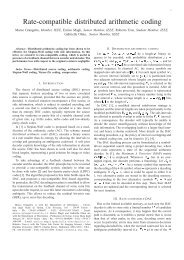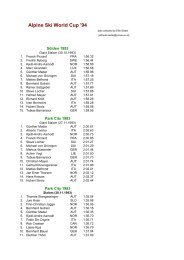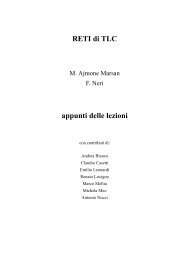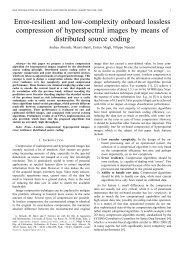Transform coding techniques for lossy hyperspectral data compression
Transform coding techniques for lossy hyperspectral data compression
Transform coding techniques for lossy hyperspectral data compression
Create successful ePaper yourself
Turn your PDF publications into a flip-book with our unique Google optimized e-Paper software.
IEEE TRANSACTIONS ON GEOSCIENCE AND REMOTE SENSING (SUBMITTED DEC. 2005) 19<br />
tile mosaicking.<br />
Part 2 of the standard provides specific tools that can be applied to <strong>hyperspectral</strong> images. In<br />
particular, the multicomponent trans<strong>for</strong>mation feature allows <strong>for</strong> spectral decorrelation by means of an<br />
external trans<strong>for</strong>m, followed by the application of JPEG 2000 to a whole block of decorrelated bands;<br />
the bands are separately decorrelated in the spatial directions by means of the 2D wavelet trans<strong>for</strong>m,<br />
whereas the rate allocation is optimized across the whole block. Since JPEG 2000 standardizes the<br />
decoder, Part 2 provides the syntax (i.e. the MCC, MCT, and MCO marker segments) to embed<br />
into the codestream the inverse spectral trans<strong>for</strong>m that must be carried out after per<strong>for</strong>ming JPEG<br />
2000 de<strong>coding</strong> of each component. Three types of spectral trans<strong>for</strong>mations are supported, namely<br />
i) array-based trans<strong>for</strong>mations (i.e., those that can be described by a set of linear equations in the<br />
input coefficients, e.g. the DCT or the KLT); ii) dependency trans<strong>for</strong>mations (i.e., those of the causal<br />
predictive type, like causal DPCM); iii) wavelet trans<strong>for</strong>ms. For each class, reversible and irreversible<br />
modes are <strong>for</strong>eseen. Irreversible trans<strong>for</strong>ms are specified <strong>for</strong> example by storing the trans<strong>for</strong>m matrix<br />
coefficients in floating-point <strong>for</strong>mat in the relevant marker segments within the codestream. Reversible<br />
trans<strong>for</strong>ms are defined as a set of single element linear trans<strong>for</strong>mations and rounding operations; this<br />
structure can accommodate lifting-based integer implementations of classical trans<strong>for</strong>ms such as DCT<br />
and wavelets (see e.g. [27], [28]).<br />
D. Integration of low-complexity KLT within JPEG 2000<br />
The proposed technique employs a hybrid 3D trans<strong>for</strong>m; it first applies the low-complexity KLT<br />
as multicomponent extension to JPEG 2000, and then the JPEG 2000 2D DWT, rate allocation and<br />
entropy <strong>coding</strong> to the spectrally trans<strong>for</strong>med bands. Three decomposition levels are per<strong>for</strong>med <strong>for</strong><br />
the 2D spatial trans<strong>for</strong>m, employing the (9,7) filter. The inverse KLT trans<strong>for</strong>m matrix is written<br />
in an MCT marker segment in the compressed file. Notably, the post-<strong>compression</strong> rate-distortion<br />
optimization is operated on the complete 3D set of trans<strong>for</strong>med coefficients, ensuring optimal<br />
per<strong>for</strong>mance.<br />
On a related note, a very desirable feature of a <strong>compression</strong> system <strong>for</strong> remote sensing images<br />
is the ability to generate quicklook images without having to fully decode the compressed file. In a<br />
typical scenario, a user would download a low spatial resolution false-color quicklook of the scene.<br />
To do so, full spectral decorrelation is necessary in order to extract the three false-color bands, and<br />
then reduced resolution de<strong>coding</strong> of each band has to be carried out. This procedure is impractical,<br />
because it requires to per<strong>for</strong>m the full spectral decorrelation to extract few channels. Moreover, it<br />
is not compliant with the JPEG 2000 standard, which requires that the spatial inverse trans<strong>for</strong>ms<br />
are per<strong>for</strong>med be<strong>for</strong>e the spectral one. On the other hand, JPEG 2000 Part 2 provides an interesting






